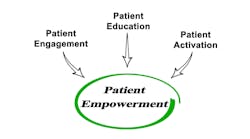Improving the Patient Experience: Geisinger’s Marketing Team Now Has a Seat at the Table
As patients are now becoming more active participants in their own health, C-suite organizational leaders are deploying strategies to help ensure their hospital or health system stands out from the pack by delivering a modern patient experience.
A big part of that process has included getting healthcare marketing teams involved at the table, as forward-thinking organizations are now realizing that meeting and exceeding patient expectations has become an imperative goal. Don Stanziano, chief marketing officer at Geisinger—a role he has held at the Danville, Pa.-based health system for about a year after coming from Scripps Health in San Diego—recently chatted with Healthcare Innovation about the intersection between healthcare and marketing and how his health system is working to improve patient experiences, digitally. Below are excerpts of that interview.
Tell me a bit about your role, and some of the things you’re working on right now?
My responsibilities include all aspects of marketing and communications for Geisinger, and that’s inclusive of digital customer engagements and strategies. So that means some of the more traditional things that you’d expect marketing to have responsibility for—the public-facing website, social media efforts, and digital marketing efforts. More recently, that has also included our patient portal, which our version of Epic’s MyChart— myGeisinger—as well as some mobile apps that are consumer-facing.
The intersection between healthcare and marketing is an intriguing one, even more so now as patients are becoming consumers and value having more options. Can you speak a bit to how this has changed over the years?
I have been in healthcare since the 1990s, in communication and marketing roles, and I would tell you that as a vertical, healthcare as changed dramatically. I remember presenting to doctors and leadership 10 to 15 years ago, using the word “consumer,” and I would get challenged. They would say they have patients, not customers. Today, that isn’t a debate. “Consumers” in healthcare is a term that’s very much understood, and that’s a good thing. Marketing has been one of the champions of that thinking and changing that perception, along with patient experience teams. Marketing has changed so dramatically in the last decade or so because of the digital channels we now have available to us.
Healthcare is just catching up in terms of what we’re now able to do, and the disruption that has occurred as the result of digital capabilities and the empowerment of consumers. And we see this in every aspect of our lives. Retail is now undergoing a massive change because people are shopping online. Healthcare is at that precipice where digital capabilities, challenges and technologies, and the consumerism of our customers, is really driving dramatic change. Marketing is at the table for all of this. We have the discipline and sensitivities to message people, leveraging the right channel at the right time for the right customer, so it’s a very exciting time to be a healthcare marketer.
How has this healthcare consumerism trend shifted Geisinger’s approach to becoming more marketable as a health system?
We have to be nimble and pay attention to what people want, and make sure it’s being made available. We have an online capability for urgent care where you can see wait times and availability for our urgent care centers, and through improvements we have made to that system, we have seen a dramatic uptick in use and traffic on the site. When we look at our front door and what services bring people into our organization, it usually starts with an online search. So being in tune to what people are looking for and then providing the right functionality online to offer up what they are looking for influences not only marketing but operations, but improves our business overall.
Can you speak more in-depth about some of these specific digital elements?
I know websites aren’t leading-edge, but they are the foundation of an entire enterprise digital strategy, because they become the source of truth for content. We have several mobile apps for specific use cases, some in the clinical setting, where we are identifying a specific clinical need and identifying a mobile app for that, making sure you have that foundation with the website. And that’s where our new physician directory is critical. Through our relationship with Kyruus [the Massachusetts-based provider data management vendor], we can provide information to consumers in the way they want it and are looking for it. So having a mobile-optimized website with content that’s highly searchable, engaging, and with two-way dialogue, allows us to gather information to serve them better in the future. But more importantly, it gets them what they’re looking for.
Regarding our Epic patient portal, we are continuing to drive membership and enrollment there. That’s been a big priority for us—increasing the number of patients we have on the myGeisinger portal. That’s a place where we can engage them in their care specifically with information that’s highly personal and privacy-protected.
[Before Kyruus], we had a legacy system that wasn’t meeting our needs because it was not offering up correct information, and was not helping us with SEO. For me, helping drive traffic to our website is critical to getting more customers. The physician directory is often one of the most trafficked sections of a health system’s website; for us, it’s second highest behind the landing page for our patient portal. And that wasn’t the case for our old system, so by making the change to Kyruus, we have seen a dramatic improvement in traffic and engagement with requested appointments. So it’s definitely helping us meet our customer’s needs.
What lessons have you learned from other sectors that are notably ahead of healthcare in creating modern consumer experiences?
Banking, travel and retail are all great examples of industries that have deployed sophisticated customer engagement technologies and leverage them to evolve their business models. That’s where healthcare is now. A great example is the update we just did with our physician directory that’s available on our public-facing website and which is mobile friendly. The one thing we know about our patients/customers is that the relationship with the doctor is primary, and the physician is usually the first entry point into our organization. So you want to make sure that if someone is looking for services and they want to find a physician who is offering those services, that the physician is easily searchable online.
We just updated our entire physician directory online to make it more robust, easily searchable, and easy for consumers. We are allowing people to request appointments, and in the last 30 days, we have seen an increase in sessions, searches, and in appointments requested.
Looking ahead a few years, how much do you think the patient access and experience environment will differ from today?
I think it will be dramatically different. The opportunity, through AI [artificial intelligence], will help us better understand the individual customer. What you might need when you come to the website or visiting the app is very different than what I need. Younger consumers particularly expect you to offer that Amazon experience and they expect you to be that sophisticated now.
And I think we will also see an explosion in virtual care delivery. The adoption there is slow; healthcare is very personal, and there are hurdles to get over to get someone comfortable using technology for their health. People want to have that face-to-face [interaction], with the caregiver physically present. Some of it is generational but some of it is inherent to healthcare. We have telemedicine pilots in place but there is not a whole lot of engagement right now. I think it will continue to improve, though.


